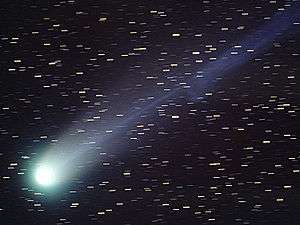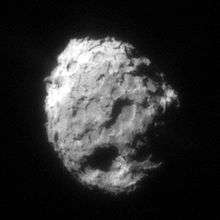22P/Kopff
|
14" reflector imaged on 2009-06-27 | |
| Discovery | |
|---|---|
| Discovered by | August Kopff |
| Discovery date | August 23, 1906 |
| Alternative designations | 1906 Q1, 1919 O1 |
| Orbital characteristics A | |
| Epoch | December 9, 2014 |
| Aphelion | 3.446 AU |
| Perihelion | 1.559 AU |
| Semi-major axis | 3.467 AU |
| Eccentricity | 0.5433 |
| Orbital period | 6.40 yr |
| Inclination | 4.737° |
| Dimensions | 3.0 km[1] |
| Last perihelion | May 25, 2009[2] |
| Next perihelion | October 25, 2015[3] |
Comet Kopff or 22P/Kopff is a periodic comet in the Solar System. Discovered on August 23, 1906, it was named after August Kopff who discovered the comet. The comet was missed on its November 1912 return, but was recovered on its June 1919 return.[2] The comet has not been missed since its 1919 return and its last perihelion passage was on May 25, 2009.[2] Close approaches to Jupiter in 1938[1] and 1943 decreased the perihelion distance and orbital period.[4][5] 22P/Kopff’s next perihelion passage is October 25, 2015.[3]
Observations
| Perihelion distance at different epochs | |||||||
| Epoch | Perihelion (AU) | ||||||
|---|---|---|---|---|---|---|---|
| 1906 | 1.70 | ||||||
| 1944 | 1.49 | ||||||
| 1957 | 1.52 | ||||||
| 1990 | 1.58 | ||||||
| 2027 | 1.32 | ||||||
| 2039 | 1.19 | ||||||
22P/Kopff was discovered at Königstuhl Observatory on Heidelberg, Germany.[5] Kopff analyzed photographic plates which he exposed on August 20, 1903 against pre-discovery images of the same region. On August 23, 1903, Kopff concluded it to be a comet with an estimated apparent magnitude of 11. On mid-September 1906, the short-period nature of the comet was recognized by a team headed by Kiel Ebell of the Berkeley Astronomical Department. The comet was missed when it made a return on November 25, 1912 however on June 25, 1919, astronomers recovered the comet. The comet was located less than three days from the predicted position. Over the next several returns to Earth, none were notable until the 1945 comet’s return when the comet peaked at magnitude 8.5. The increase in brightness was a result of Jupiter altering the comet’s orbit between the years of 1939 to 1945. This change in orbit brought the comet closer to the Sun. The 1951 return was unique due to the comet being 3 magnitudes fainter than what was expected when recovered in April 1951. But the comet still reached magnitude 10.5 in October 1951. A very close pass to Jupiter in 1954 increased the comet’s perihelion distance to 1.52 AU and increased the orbital period to 6.31 years.[5] On November 30, 1994, Carl W. Hergenrother was able to recover the comet at a stellar magnitude of 22.8 using the 1.5-m reflector at the Catalina Sky Survey.[5] The comet reached magnitude 7 during the 1996 perihelion passage.[6]
The comet nucleus is estimated to be 3.0 kilometers in diameter with an albedo of 0.05.[1] The nucleus is dark because hydrocarbons on the surface have been converted to a dark, tarry like substance by solar ultraviolet radiation.
References
- 1 2 3 "JPL Small-Body Database Browser: 22P/Kopff" (last observation: 2014-03-29). Jet Propulsion Laboratory. Retrieved 2014-10-27.
- 1 2 3 "22P/Kopff (Returns and Appearances)". Seiichi Yoshida Comet Catalog. Retrieved 2010-02-24.
- 1 2 Syuichi Nakano (2009-02-16). "22P/Kopff (NK 1749)". OAA Computing and Minor Planet Sections. Retrieved 2010-03-04.
- ↑ "22P at Kazuo Kinoshita's Comets". 2014-02-13.
- 1 2 3 4 Kronk, Gary W. "22P/Kopff". Cometography. Retrieved 2010-02-25.
- ↑ "22P/Kopff (1996)". Seiichi Yoshida. Retrieved 2010-02-25.
External links
- Orbital simulation from JPL (Java) / Ephemeris
- Elements and Ephemeris for 22P/Kopff – Minor Planet Center
- 22P/Kopff at CometBase
- 22P – Gary W. Kronk's Cometography
- 22P at Kazuo Kinoshita's Comets
- 22P/Kopff / 2009 – Seiichi Yoshida @ aerith.net
| Numbered comets | ||
|---|---|---|
| Previous 21P/Giacobini–Zinner |
22P/Kopff | Next 23P/Brorsen–Metcalf |


